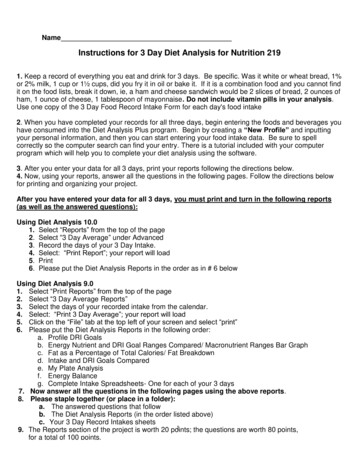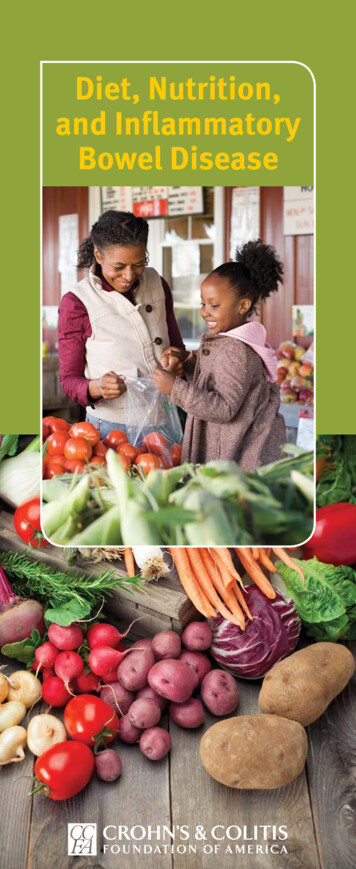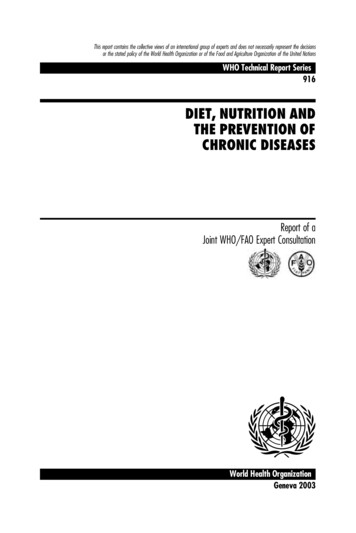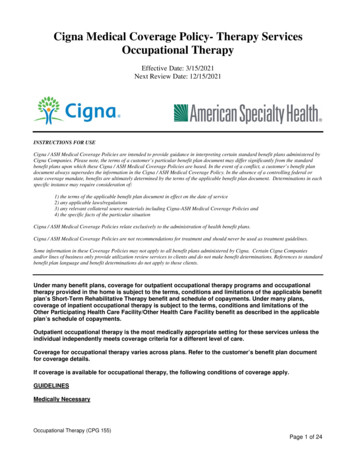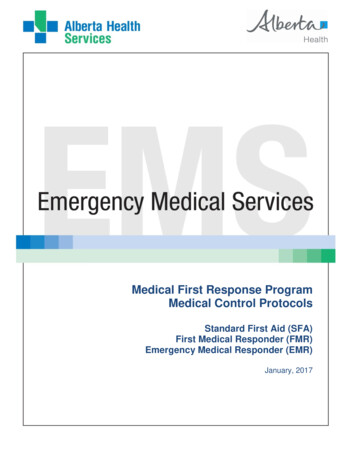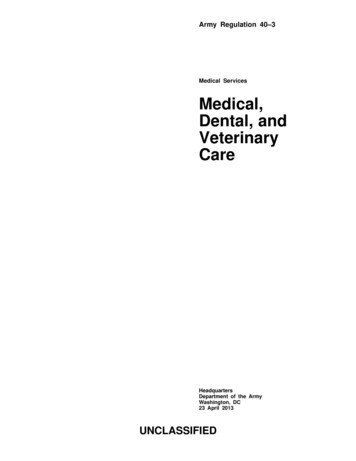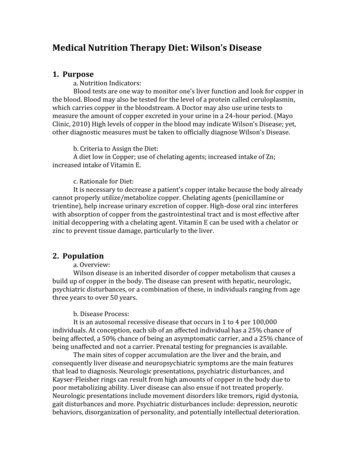
Transcription
Medical Nutrition Therapy Diet: Wilson’s Disease1. Purposea. Nutrition Indicators:Blood tests are one way to monitor one’s liver function and look for copper inthe blood. Blood may also be tested for the level of a protein called ceruloplasmin,which carries copper in the bloodstream. A Doctor may also use urine tests tomeasure the amount of copper excreted in your urine in a 24-hour period. (MayoClinic, 2010) High levels of copper in the blood may indicate Wilson’s Disease; yet,other diagnostic measures must be taken to officially diagnose Wilson’s Disease.b. Criteria to Assign the Diet:A diet low in Copper; use of chelating agents; increased intake of Zn;increased intake of Vitamin E.c. Rationale for Diet:It is necessary to decrease a patient’s copper intake because the body alreadycannot properly utilize/metabolize copper. Chelating agents (penicillamine ortrientine), help increase urinary excretion of copper. High-dose oral zinc interfereswith absorption of copper from the gastrointestinal tract and is most effective afterinitial decoppering with a chelating agent. Vitamin E can be used with a chelator orzinc to prevent tissue damage, particularly to the liver.2. Populationa. Overview:Wilson disease is an inherited disorder of copper metabolism that causes abuild up of copper in the body. The disease can present with hepatic, neurologic,psychiatric disturbances, or a combination of these, in individuals ranging from agethree years to over 50 years.b. Disease Process:It is an autosomal recessive disease that occurs in 1 to 4 per 100,000individuals. At conception, each sib of an affected individual has a 25% chance ofbeing affected, a 50% chance of being an asymptomatic carrier, and a 25% chance ofbeing unaffected and not a carrier. Prenatal testing for pregnancies is available.The main sites of copper accumulation are the liver and the brain, andconsequently liver disease and neuropsychiatric symptoms are the main featuresthat lead to diagnosis. Neurologic presentations, psychiatric disturbances, andKayser-Fleisher rings can result from high amounts of copper in the body due topoor metabolizing ability. Liver disease can also ensue if not treated properly.Neurologic presentations include movement disorders like tremors, rigid dystonia,gait disturbances and more. Psychiatric disturbances include: depression, neuroticbehaviors, disorganization of personality, and potentially intellectual deterioration.
Kayser-Fleischer rings result from copper deposition in Descemet's membrane ofthe cornea and reflect a high degree of copper storage in the body.c. Biochemical and Nutrient Needs:First and foremost, foods high in copper should be restricted since the bodycannot metabolize it effectively. Furthermore, zinc can prevent the development ofhepatic, neurologic, and psychiatric findings in asymptomatic affected individualsand can reduce findings in many symptomatic individuals. Lifelong treatment withchelating agents is initiated as soon as possible. Such agents are penicillamine ortrientine, and they increase urinary excretion of copper. High-dose oral zincinterferes with absorption of copper from the gastrointestinal tract and is mosteffective after initial decoppering with a chelating agent. Antioxidants, such asvitamin E, can be used with a chelator or zinc to prevent tissue damage, particularlyto the liver.3. General Guidelinesa. Nutrition Rx:There is no specific nutrition prescription or requirements for patients withWilson’s Disease, with the exception that food choices should contain ( 1mgCu/serving).RDA for Vitamin E: 20mg/dayRDA for Zn: 15mg/dayRDA for Cu: 2 mg In patients with Wilson’s disease daily intake should be 1mg/day.b. Adequacy of Nutrition RxAll other nutritional requirements/recommendations remain the same forpatients with Wilson’s disease. The only one that should be closely monitored is Cu.c. GoalsA diet low in Copper with additional supplementation of Vitamin E and Znwill help keep Cu levels somewhat in balance, help protect liver tissue damage, anddecrease the absorption of Cu into the GI system.d. Does it Meet DRIAll nutrients should meet the DRI with the exception of Cu, but this iscompensated by the inadequate metabolism of the mineral.4. Education Materiala. Nutrition Therapy:Provide patient with a chart of acceptable foods (low-Cu containing) andnon-acceptable foods. Explain the pathophysiology to patient to help themunderstand the vital role that a low Cu diet plays in the progression of their disease.Provide sample menus for them to comply and use the readiness to change ruler to
assess self-efficacy.b. Ideas for ComplianceAdvise patient to group sessions with other patients suffering from Wilson’sDisease. Groups are available through the Wilson Disease Association. Whendiagnosis is new, ask patients to keep a food journal to monitor their intake and tokeep a close record of their food choices.5. Sample Menua. Foods Recommended:Foods low in copper ( 1mg/serving), high in vitamin E, smaller portions ofmeat to decrease copper consumption, non-copper utensils, and water that contains 100 micrograms per liter to demineralizes high copper amounts.Acceptable meats include: beef, eggs, white meat turkey & chicken, cold cutsand frankfurters that do not contain pork, dark turkey, dark chicken, or organmeats. Most vegetables besides mushrooms and most fruits besides home-driedfruits are acceptable. Recommended beverages include: coffee, tea, fruit juices, fruitflavored beverages, and lemonade.b. Foods to Avoid:Liver, brain, chocolate, mushrooms, soy milk, shellfish and nuts are all high incopper and should be avoided. Alcohol should also be avoided because it can harman already compromised liver.c. Example of a meal plan:Sample MenuBreakfast grapefruit 1/2 cup scrambled egg 1 white toast 1 slice margarine 1 tsp skim milk 1/2 cup coffee 1 cup salt/pepperLunchDinner white bread 2slices chicken breast 3 oz rice 1/.2 cup roast beef 2 ozlettucetomatomayonnaise 1Tbsp green beans 1/2cup margarine 1 tsp white bread 1 slice carrot sticks 6 jelly 1 tsp fresh orange 1 apple 1 skim milk 1/2cup lemonade 1 cup salt/pepper
This Sample Diet Provides the FollowingCalories1520Protein69 gmCarbohydratesFat191 gmSodium1500 mgPotassium2150 mgCopper0.68 mg54 gmProvided by: Jackson Siegelbaum Gastroenterology. Low Copper Diet forWilson’s Disease. (2008). Retrieved on April 15, 2010, px6. Websitesa. Organizations with WebsitesJackson Siegelbaum Gastroenterology. Low Copper Diet for Wilson’s Disease.(2008). son’s Disease Association International. sease/dietandnutrition.htmlMayo Clinic. Wilson’s Disease. 00411b. Government WebsitesNational Institute of Health. Wilson’s cgi?book gene&part wilson7. Referencesa. Journal articles referencesLorincz, M. (2010). Neurologic Wilson's disease. Annals of the New YorkAcademy of Sciences, 1184(1), 173-187. doi:10.1111/j.1749-6632.2009.05109.x.Shimizu, N., Yamaguchi, Y., & Aoki, T. (1999). Treatment and management ofWilson’s disease. Pediatrics International, 41(4), 419-422. doi:10.1046/j.1442200X.1999.01093.x.
NUTRIENT1. What is the nutrient?Sodium2. What is the RDA/DRI for the nutrient?There is no defined RDA for sodium because it has never lacked in thediet, but the RDA’s general rule is 2,400 mg per day.3. How is the nutrient metabolized?Sodium is an electrolyte that helps regulate water levels in the fluid inand around one’s cells. It helps transmit nerve impulses, and influences thecontraction and relaxation of muscles. The kidneys regulate the amount ofsodium kept in your body. When sodium levels are low, the kidneys conservesodium. When levels are high, they excrete the excess amount in urine.4. What are food sources of the nutrient?Sodium occurs naturally in some foods such as: Milk, beets, celery andeven drinking water. However, the most common form of sodium is sodiumchloride, which is table salt.Sodium is added to many food products in the form of: monosodiumglutamate, sodium nitrite, sodium saccharin, baking soda (sodium bicarbonate),and sodium benzoate. These are ingredients in condiments and seasonings suchas Worcestershire sauce, soy sauce, onion salt, garlic salt, and bouillon cubes.Processed meats, such as: bacon, sausage, ham, canned soups andvegetables are all examples of foods that contain added sodium.5. What disease states alter the nutrients’metabolism?Kidney Disease: Too much sodium can be harmful for people with kidneydisease because sodium helps one’s body to retain a healthy fluid balance. Butwith renal disease, kidneys cannot eliminate excess sodium and fluid from thebody. As sodium and fluid build up in the tissues and bloodstream, bloodpressure increases.Hypertension: (High Blood Pressure) Increased salt intake causes morefluid to be retained in the blood vessels. This increased volume of blood requiresthe heart to work harder to pump blood to all the tissues in the body. Increasing
the blood’s volume within the enclosure of the circulatory system is one waythat salt increases blood pressure. Salt can also elevate blood pressure throughthe action of the arterioles. Arterioles are blood vessels that dilate and constrictto regulate blood pressure and blood flow. By contracting under the influence ofsodium, arterioles effectively increase the resistance to blood movement andlessen the volume of blood that is returned to the heart. This action alsoincreases blood pressure. High BP can lead to heart disease, kidney disease orstroke.Hypotension: (Low Blood Pressure) The causes of low blood pressure canrange from dehydration to problems with the way your brain signals your heartto pump blood. Low blood pressure is treatable, but it is important to find outwhat is causing your condition so that it can be properly treated.6. What are the tests or procedures to assessthe nutrient level in the body?A sodium test is done by drawing blood from the patient to assess thewater and electrolyte balance of the body, find the causes of high and low levels,and/or to check the progress of kidney disease or adrenal glands.Blood pressure is another diagnostic procedure to see if a patient hashigh blood pressure which is directly correlated with one’s sodium intake. It is aquick, painless test using a medical instrument called a sphygmomanometer andmeasures the systolic and diastolic pressure between heartbeats. Normal is120/80 mmHg.7. What is the drug –nutrient interactions?Drugs that can potentially interfere with diclofenac sodium include:diuretics, other nonsteroidal anti-inflammatory drugs, and some herbalsupplements. These interactions may increase the risk of kidney damage, reducethe activity of diuretics, or make ACE inhibitors less effective, among otherthings.8. How is the nutrient measured?The nutrient is in milligrams.9. What is the Upper Tolerable Limits?A tolerable upper intake level (UL) -- is set at 5.8 grams of salt (2.3 gramsof sodium) per day.10. What are the physical signs of deficiency?Low levels of sodium in the diet (hypotension) can lead to: dizziness,fainting, dehydration, lack of concentration, blurred vision, nausea, fatigue,thirst, serious heart, endocrine or neurological disorders. Shock can result when
extremely low levels are reached; depriving the brain and other vital organs ofoxygen and nutrients.11. What are physical signs of toxicity?Signs of sodium toxicity include swelling in the extremities and highblood pressure. Sodium causes more calcium to be lost in the urine, and highcontents of sodium can also increase risks for osteoporosis.
Medical Nutrition Therapy Diet: Wilson’s Disease 1. Purpose a. Nutrition Indicators: Blood tests are one way to monitor one’s liver function and look for copper in the blood. Blood may also be tested for the level of a protein called ceruloplasmin, which carries copper

